

As America’s economy continues to shift from heavy industry to technology, certain areas of the country have gained a reputation for innovation.
Many factors contribute to differences in innovation activity in U.S. cities, including the presence of research institutions, efforts by local government and chambers of commerce, access to venture capital, and the ability of leadership to read the tea leaves of the future.
24/7 Wall St. has compiled a list of the 25 most innovative cities in the United States based on data obtained from the U.S. Patent and Trademark Office for the year 2015, the most recent year that data is available. 24/7 Wall St. listed the metropolitan areas with the highest number of patents issued per 100,000 city residents.
Many of the metropolitan areas on this list are home to major research institutions, as well as some of the nation’s largest companies in STEM fields, both of which tend to be the primary producers of patented technology.
Click here to see the 25 most innovative cities.
Click here read our detailed findings and methodology.
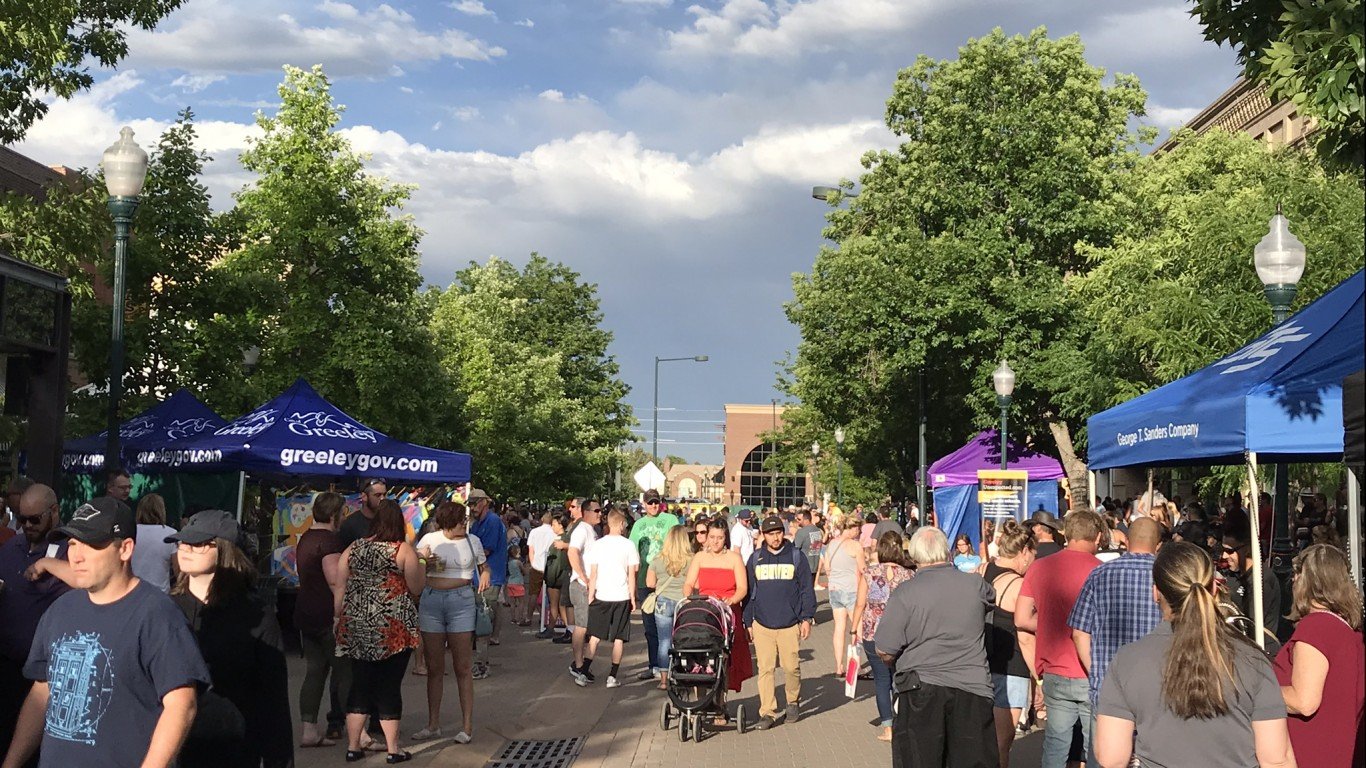
25. Greeley, CO
> Patents granted in 2015 per 100,000 residents: 98.2
> Patents granted in 2015: 3,120
> Population: 285,174
> Adults with at least a bachelor’s degree: 27.5%
Colorado has become a hot spot for innovators because of its robust outdoor culture and progressive mindset. Greeley is benefiting from this influx of entrepreneurs and those with big ideas. The city is home to the University of Northern Colorado, one of the biggest employers in Greeley. The university has an office of research that engages with innovators to discuss their ideas, show them how to protect their intellectual property, and how to apply for patents, copyrights, and trademarks.
Greeley is the fifth fastest growing city in the United States over the 2010-2017 period, with a population increase of 19.8%.
[in-text-ad]
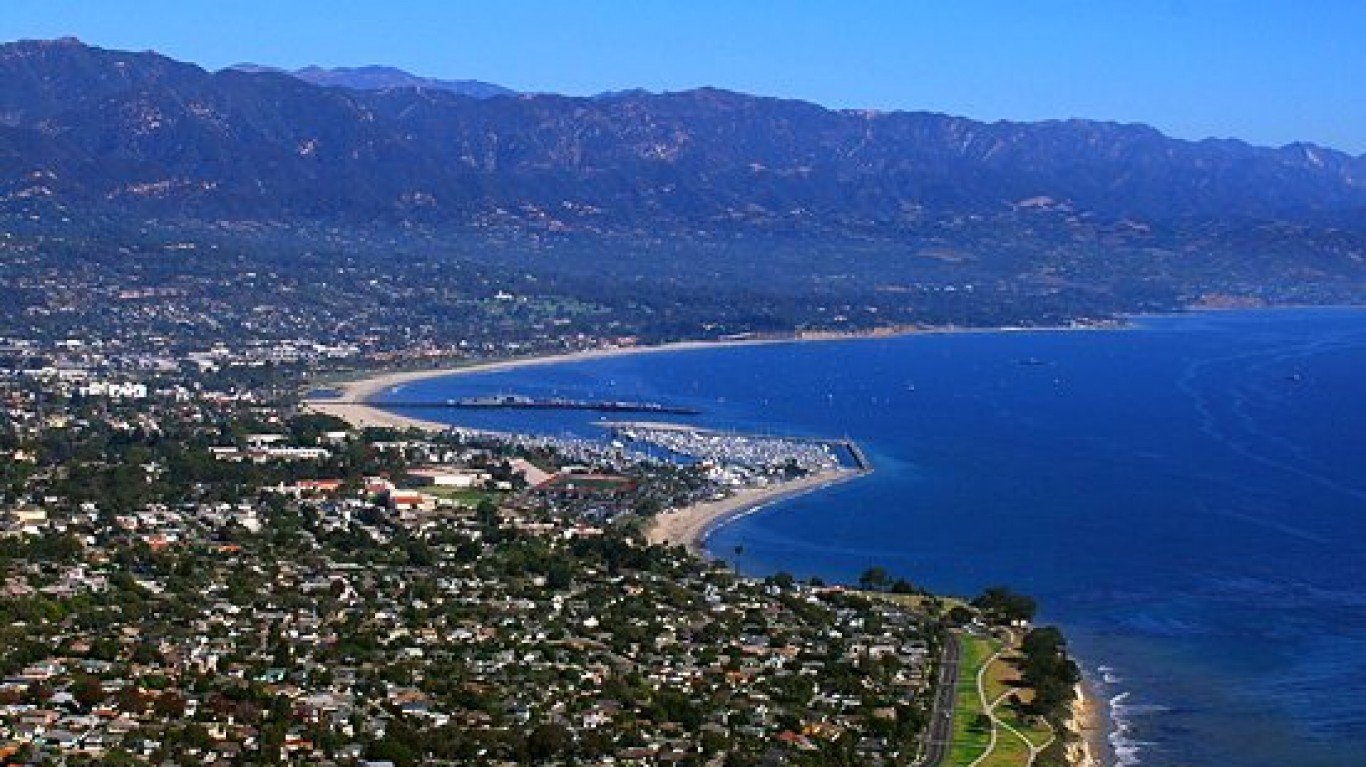
24. Santa Barbara-Santa Maria-Goleta, CA
> Patents granted in 2015 per 100,000 residents: 105.2
> Patents granted in 2015: 4,130
> Population: 444,769
> Adults with at least a bachelor’s degree: 35.2%
Santa Barbara-Santa Maria-Goleta is attracting entrepreneurs with its startup accelerator program that helps create and fund emerging businesses. Santa Clara is also home to a university with a technology management program. Among the technology companies with a major presence in the area is defense contractor Raytheon Electronic Systems. Vandenberg Air Force Base, one of the biggest military installations in the nation, is also in the region.
The area’s favorable climate and oceanfront location may make it a more attractive location for startups.
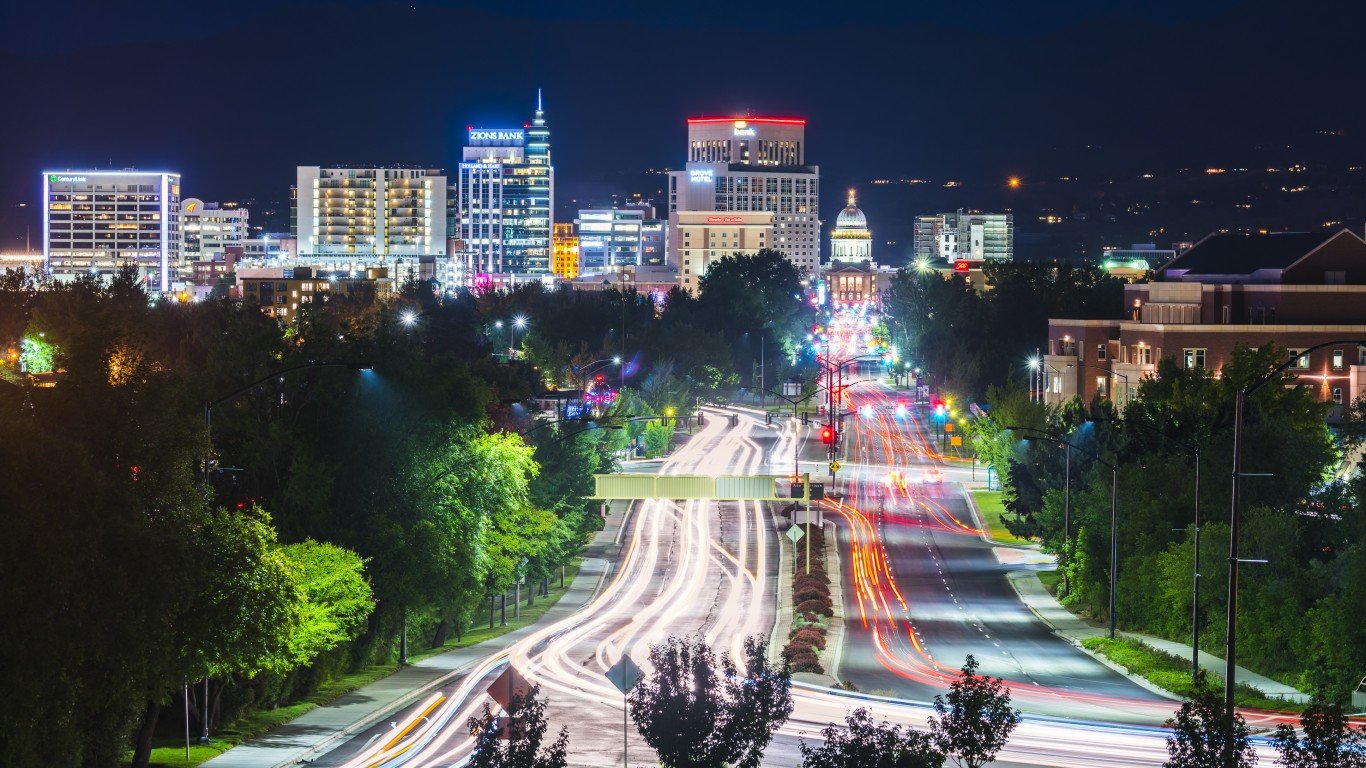
23. Boise City-Nampa, ID
> Patents granted in 2015 per 100,000 residents: 106.8
> Patents granted in 2015: 19,188
> Population: 675,800
> Adults with at least a bachelor’s degree: 30.1%
Boise City is the capital of Idaho and the state’s most populous city. Boise has more than 3,000 high-tech employers, according to Brookings Institution. Among them is memory-chip maker Micron Technology Inc. Nampa, 23 miles west of Boise, touts its technology and entrepreneurial hubs, such as the Boise State University TECenter, as well as two other universities. The city has also partnered with the SBDC Business Accelerator to back entrepreneurship in Nampa. The city also formed a group called Nampa Entrepreneurs Organized that looks to connect with aspiring entrepreneurs and direct them to networking and educational resources.
Boise CIty is one of the fastest growing cities in the country, with a 14.9% population growth from 2010 to 2017.

22. Peoria, IL
> Patents granted in 2015 per 100,000 residents: 108.8
> Patents granted in 2015: 3,321
> Population: 376,987
> Adults with at least a bachelor’s degree: 30.0%
Peoria, situated on the Illinois River in the central part of Illinois, is home to heavy machinery giant Caterpillar Inc.. It is also home to the NEXT Innovation Center, which brings together researchers, inventors, and entrepreneurs. The facility, which operates under the auspices of Bradley University, opened in 2007 and can house as many as 27 companies. Its stated mission is to “provide an entrepreneurial environment that enables success through shared knowledge and resource collaboration.”
[in-text-ad-2]
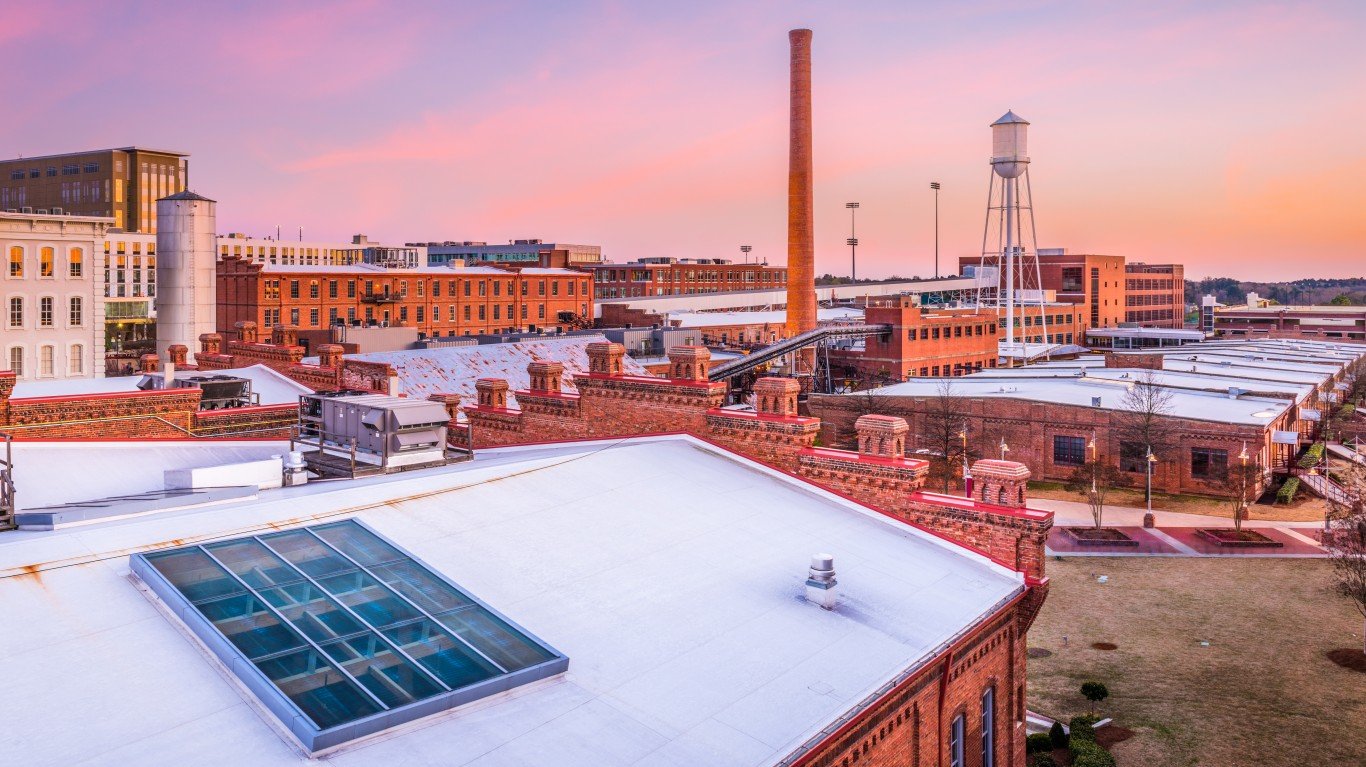
21. Durham-Chapel Hill, NC
> Patents granted in 2015 per 100,000 residents: 109.9
> Patents granted in 2015: 6,861
> Population: 552,493
> Adults with at least a bachelor’s degree: 46.9%
It is no surprise that Durham-Chapel Hill, which is ensconced in the Research Triangle of North Carolina, made the list. There are two major research universities in the region — Duke University in Durham and the University of North Carolina in Chapel Hill. Within the Research Triangle is the Research Triangle Regional Partnership, an economic development group that works to provide businesses with resources to help them expand or relocate to the region.
There are about 275 companies within the Research Triangle Park, among them tech giants Cisco Systems, IBM, and biotechnology company Biogen. Almost 47% of adults in the region hold a bachelor’s degrees or higher, well above the U.S. average of 32%.
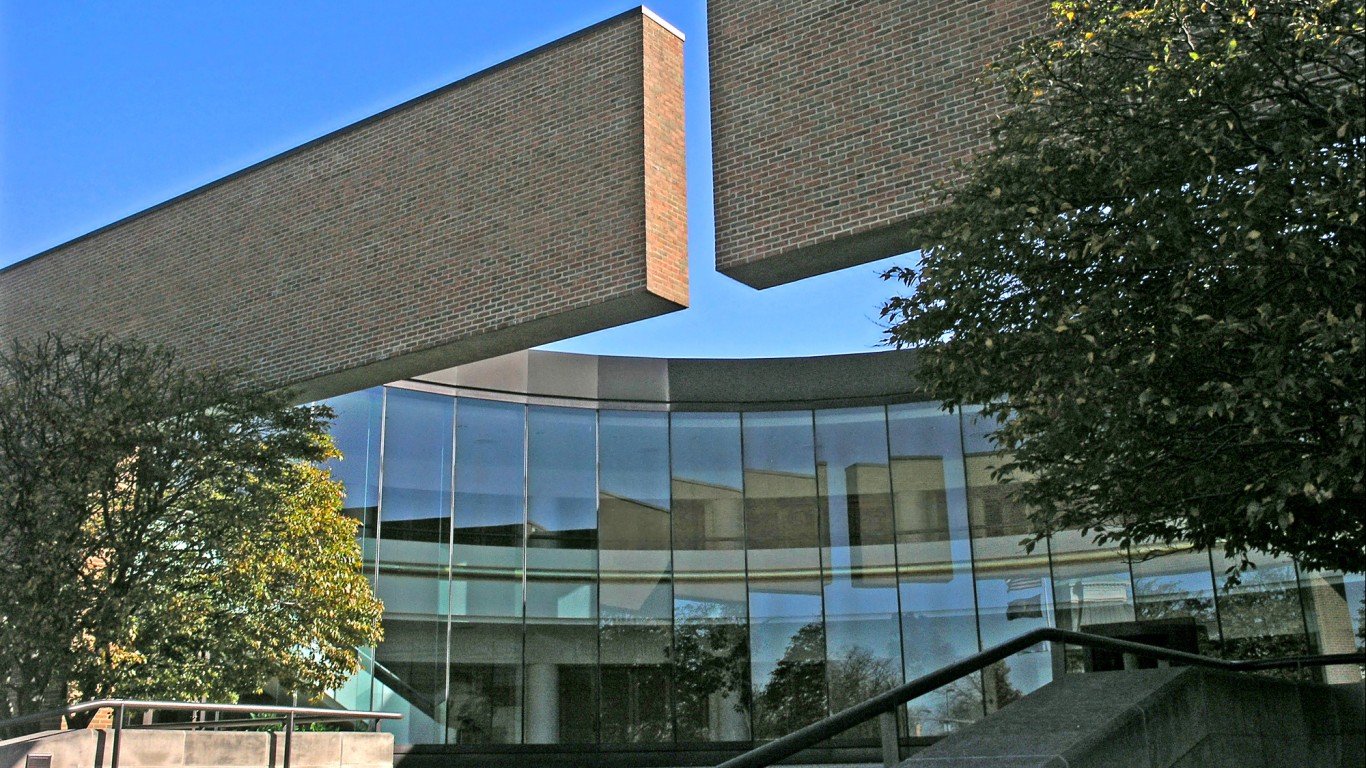
20. Columbus, IN
> Patents granted in 2015 per 100,000 residents: 112.1
> Patents granted in 2015: 816
> Population: 81,162
> Adults with at least a bachelor’s degree: 35.1%
Columbus, Indiana, is the smallest city on the list, with a population of just over 81,000 people. The city is about 40 miles south of Indianapolis and is known for its architecture, which boasts the works of luminaries such as Eero Saarinen, Kevin Roche, and I.M. Pei. Columbus received the imprimatur of the American Institute of Architects, which ranked the city sixth in the United States for innovation and design. Some of the biggest employers in Columbus are manufacturing companies Cummins Engine and Emcon Technologies.
Columbus had the fewest utility patents issued in 2015 among the 25 cities on the list, with just 91.
[in-text-ad]
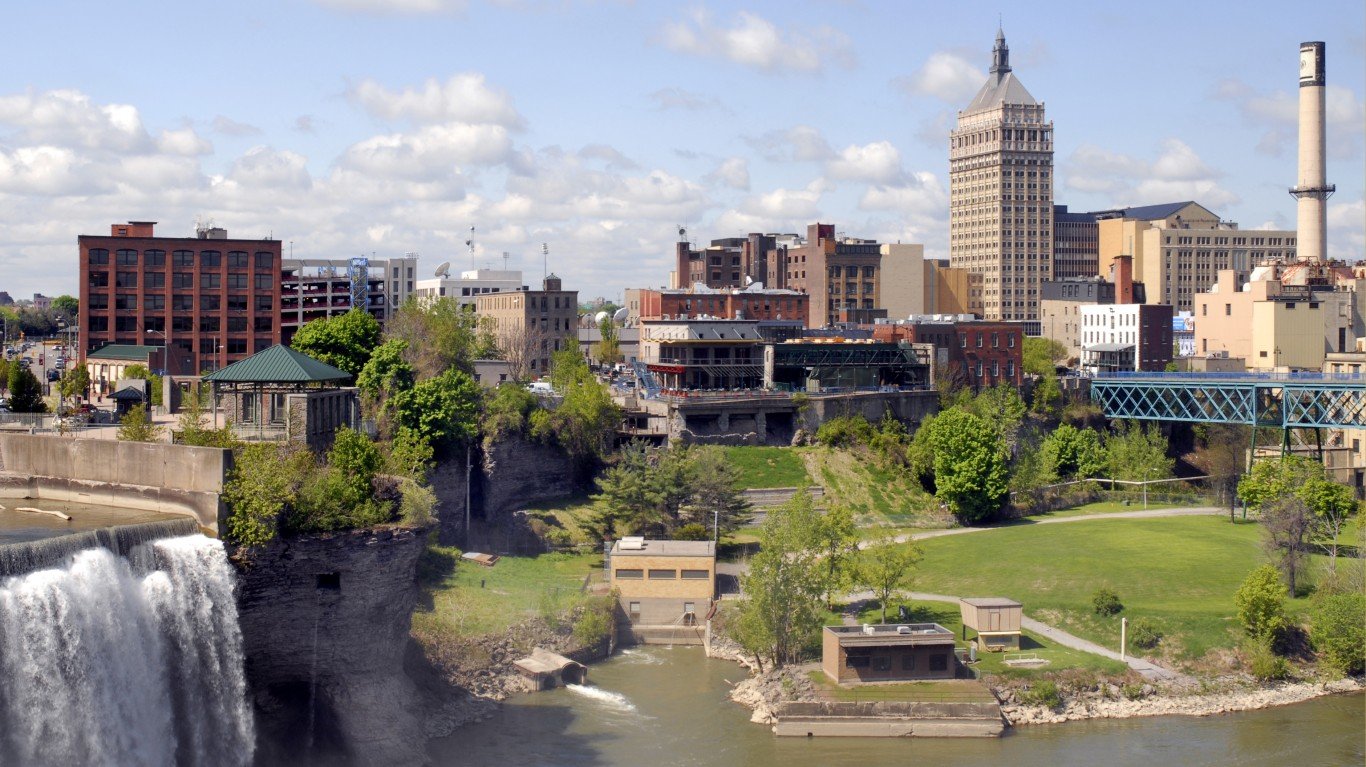
19. Rochester, NY
> Patents granted in 2015 per 100,000 residents: 112.5
> Patents granted in 2015: 20,239
> Population: 1,081,954
> Adults with at least a bachelor’s degree: 34.1%
.
Rochester, New York, home to the headquarters of stalwarts like Eastman Kodak, Xerox, and Bausch & Lomb, has a diversified economy and is adding jobs in education and health care. The University of Rochester is the city’s biggest employer with 29,003 workers. The Rochester Regional Health system is second, employing almost 16,000 people. Another institution of higher learning is the Rochester Institute of Technology.
The city has created a downtown renovation zone — called RocDiz — to help the startup and research community. According to a Brookings Institution report from 2013, Rochester ranked with San Francisco, Boston, and Austin as among the places that produce high numbers of patents. In Rochester, those include patents for optics research.
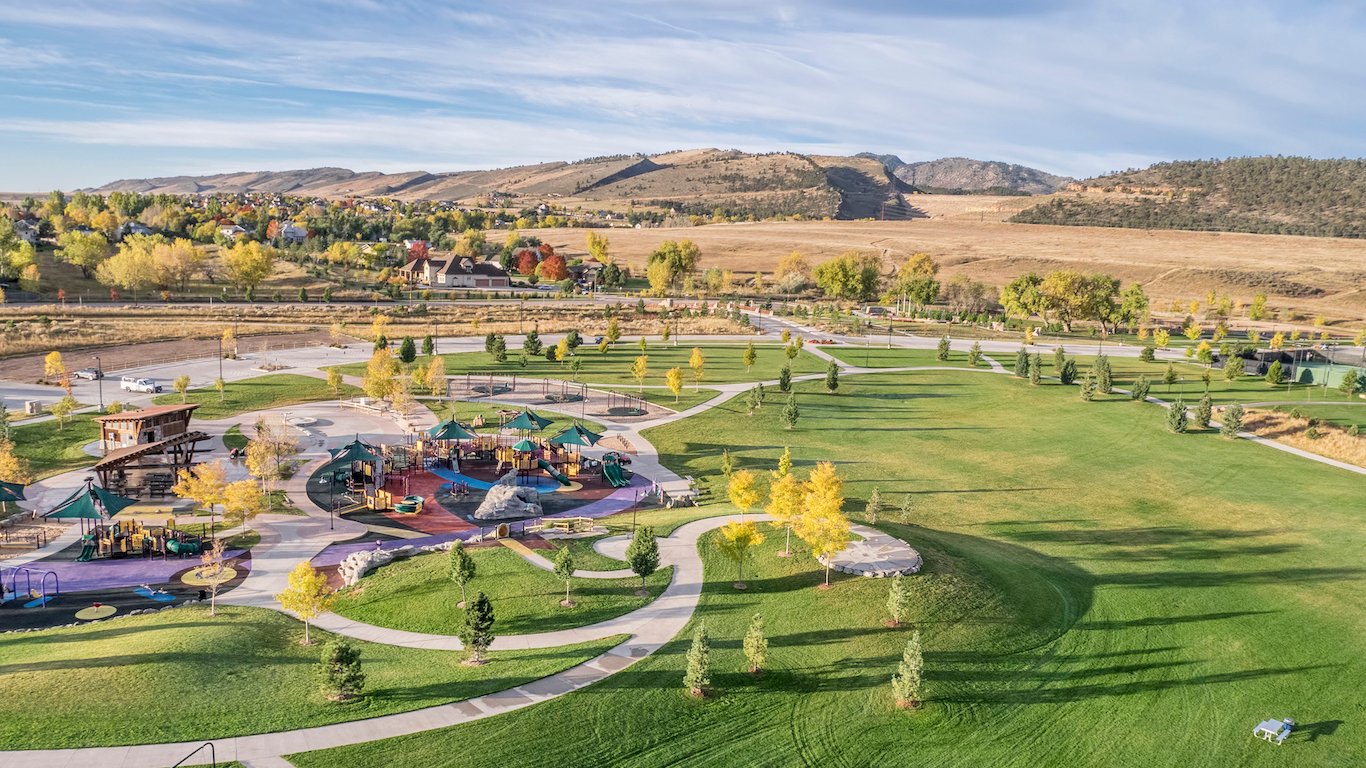
18. Fort Collins-Loveland, CO
> Patents granted in 2015 per 100,000 residents: 117.5
> Patents granted in 2015: 5,861
> Population: 333,577
> Adults with at least a bachelor’s degree: 47.9%
Fort Collins appears frequently on lists of best places to live in the United States as people flock to Colorado for its outdoors lifestyle. The city is also home to Colorado State University. Other universities in the region are the University of Colorado and the University of Northern Colorado. Stephan Weiler, professor of economics at Colorado State University in Fort Collins, told 24/7 Wall St. in interview earlier this year that Colorado’s economy has gotten away from being too reliant on energy and has diversified. He cited sectors such as information services, higher-end services, architecture, and engineering as areas of growth.
As for Loveland, Entrepreneur.com ranked the city second among its 25 best U.S. cities for tech startups in August 2013. Loveland is home to the Rocky Mountain Center for Innovation and Technology.
Fort Collins-Loveland has the 10th-highest bachelor’s degree and high school attainment rates of any metro area in the nation. The region’s highly-educated workforce points to the presence of companies that rely on research and development.
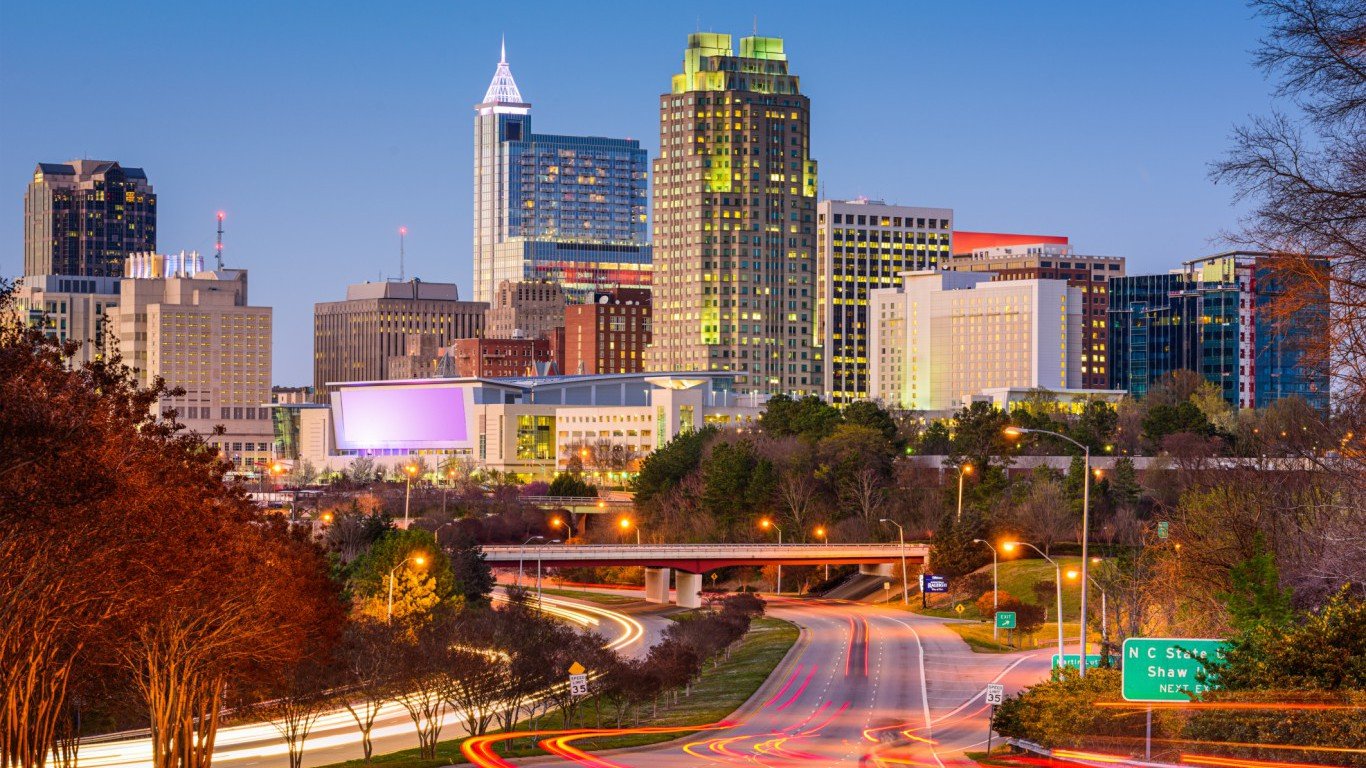
17. Raleigh-Cary, NC
> Patents granted in 2015 per 100,000 residents: 120.5
> Patents granted in 2015: 15,950
> Population: 1,273,568
> Adults with at least a bachelor’s degree: 46.2%
Another part of the Research Triangle is Raleigh-Cary, North Carolina. Research university North Carolina State is located in Raleigh. Innovate Raleigh was created in 2011 and its stated mission is to make the region “the top center for innovation and entrepreneurship in the nation.” The group tries to bring together entrepreneurs, investors, and other stakeholders. Among the developments this year was the news in February that Irvine, California-based cloud services provider RapidScale was opening its East Coast headquarters in Raleigh.
Earlier this year, Cary was one of five recipients of the 2018 challenge grant by the Smart Cities Council, an organization focused on sustainable solutions. The grant will be used to help build infrastructure, open data platforms, create public wi-fi, and other initiatives.
[in-text-ad-2]
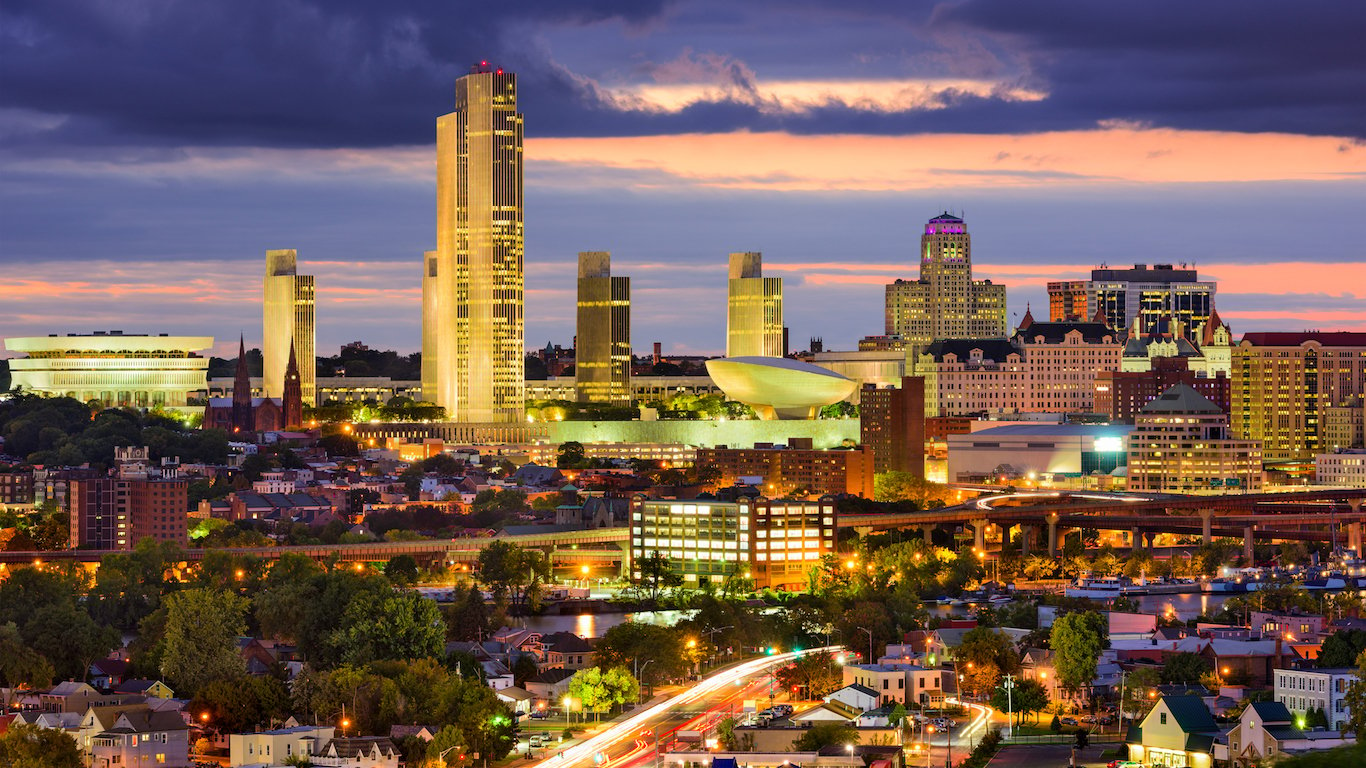
16. Albany-Schenectady-Troy, NY
> Patents granted in 2015 per 100,000 residents: 123.6
> Patents granted in 2015: 10,841
> Population: 881,830
> Adults with at least a bachelor’s degree: 37.2%
The Albany-Schenectady-Troy region benefits from institutions such as the University of Albany. The school has an Office for Innovation Development and Commercialization that tries to help faculty and students identify innovations that emerge from their research and shield intellectual property, patents, trademark, and copyrights.
In 2016, Schenectady launched the Electric City Innovation Center (now called URBAN CO-WORKS) in the city’s downtown district designed to boost startups. Troy, which forged the metal plates for the Union ironclad the USS Monitor during the Civil War, has created the Troy Innovation Garage, an open workspace facility that allows emerging companies to commingle in a space near downtown.
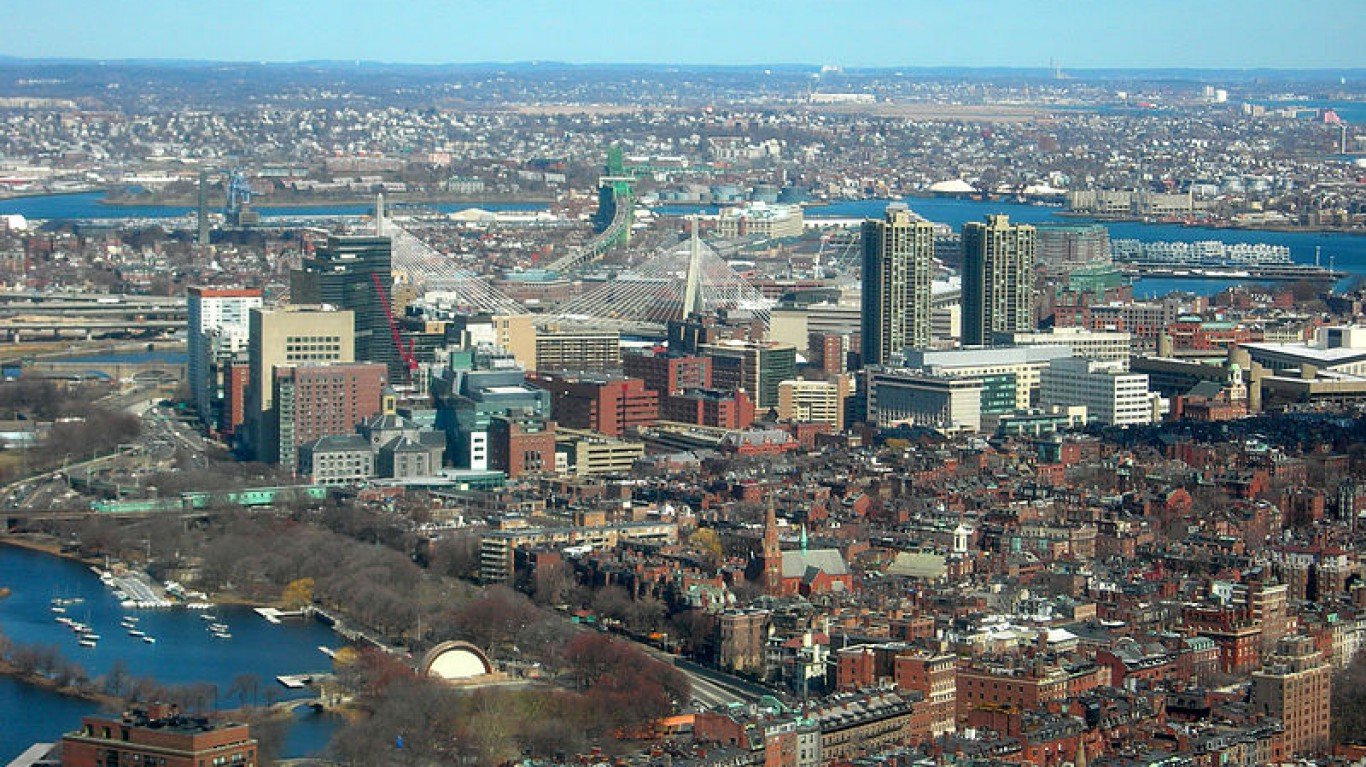
15. Boston-Cambridge-Quincy, MA-NH
> Patents granted in 2015 per 100,000 residents: 124.6
> Patents granted in 2015: 62,653
> Population: 4,774,321
> Adults with at least a bachelor’s degree: 47.6%
The Boston region, the most populous on the list, has been at the forefront of technological innovation. Massachusetts has been aggressive in luring biotechnology companies to the state. These companies can work closely with the area’s numerous institutions of higher learning, among them Harvard University and the Massachusetts Institute of Technology. The U.S. Chamber of Commerce picked Boston as the top city for supporting entrepreneurial opportunity for the second straight year. The organization based its decision on the number of startups as well as access to capital and a steady stream of young tech talent.
The area’s ability to attract talent has enabled it to become a leader in fields such as biotechnology and the life sciences. The city, working with IBM, created StartHub, an online platform intended to link the region with tech companies and startups.
Boston accounted for 5,949 patents in 2015, the fifth most among metropolitan areas.
[in-text-ad]
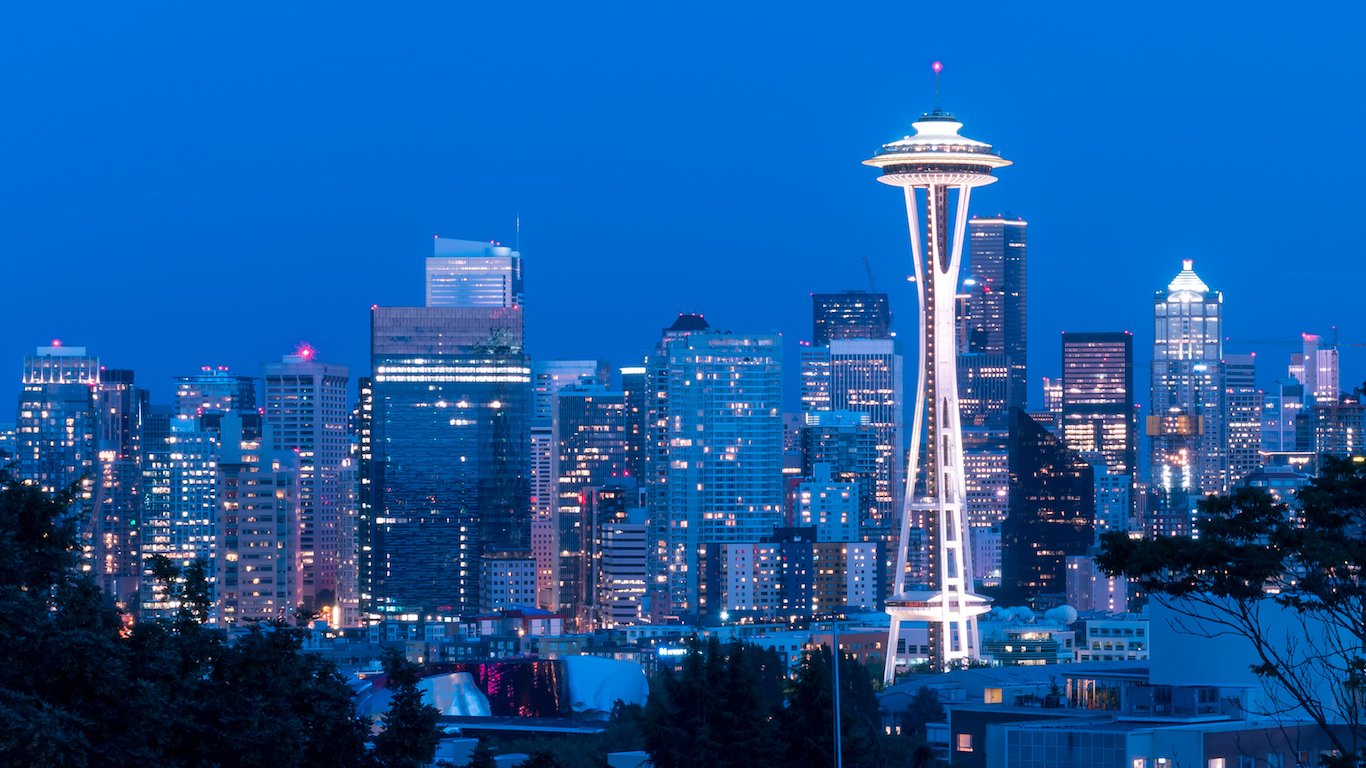
14. Seattle-Tacoma-Bellevue, WA
> Patents granted in 2015 per 100,000 residents: 126.9
> Patents granted in 2015: 44,406
> Population: 3,733,580
> Adults with at least a bachelor’s degree: 41.9%
Innovation Leader magazine last year named Seattle as the fifth most innovative city in the United States. Microsoft and Amazon are a big part of Seattle’s tech landscape, according to the report. Microsoft has a strong physical presence and research facilities in the suburb of Redmond, and Amazon is constructing buildings in downtown Seattle. Amazon’s e-commerce innovations have disrupted the retail sector worldwide. The University of Washington, a public research university, houses two accelerator programs. The school also hosts Startup Weekend, during which participants try to create a startup within 54 hours.
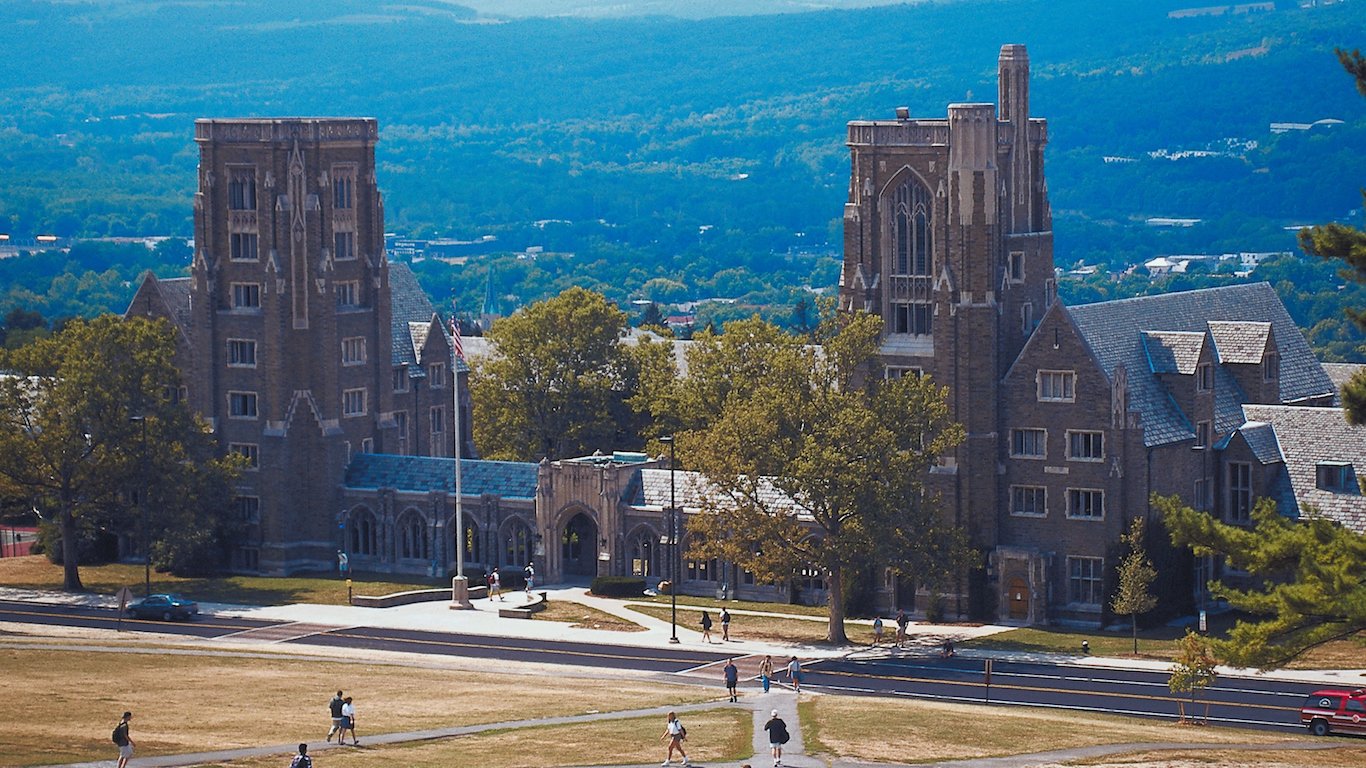
13. Ithaca, NY
> Patents granted in 2015 per 100,000 residents: 133.4
> Patents granted in 2015: 1,638
> Population: 104,926
> Adults with at least a bachelor’s degree: 52.2%
Ithaca, with a population of about 104,000, is the third smallest city on our list. It is home to Cornell University and Ithaca College. Cornell has created the Cornell Center for Regional Economic Advancement that supports economic progress through innovation and entrepreneurship. As part of that mission, the initiative has backed programs such as Rev: Ithaca Startup Works and the Southern Tier Startup Alliance. Ithaca College hosts an annual educational technology day that draws national and local vendors. Included among the vendors at the most recent event was specialty glass and ceramics company Corning Inc., whose headquarters is 35 miles southwest of Ithaca.
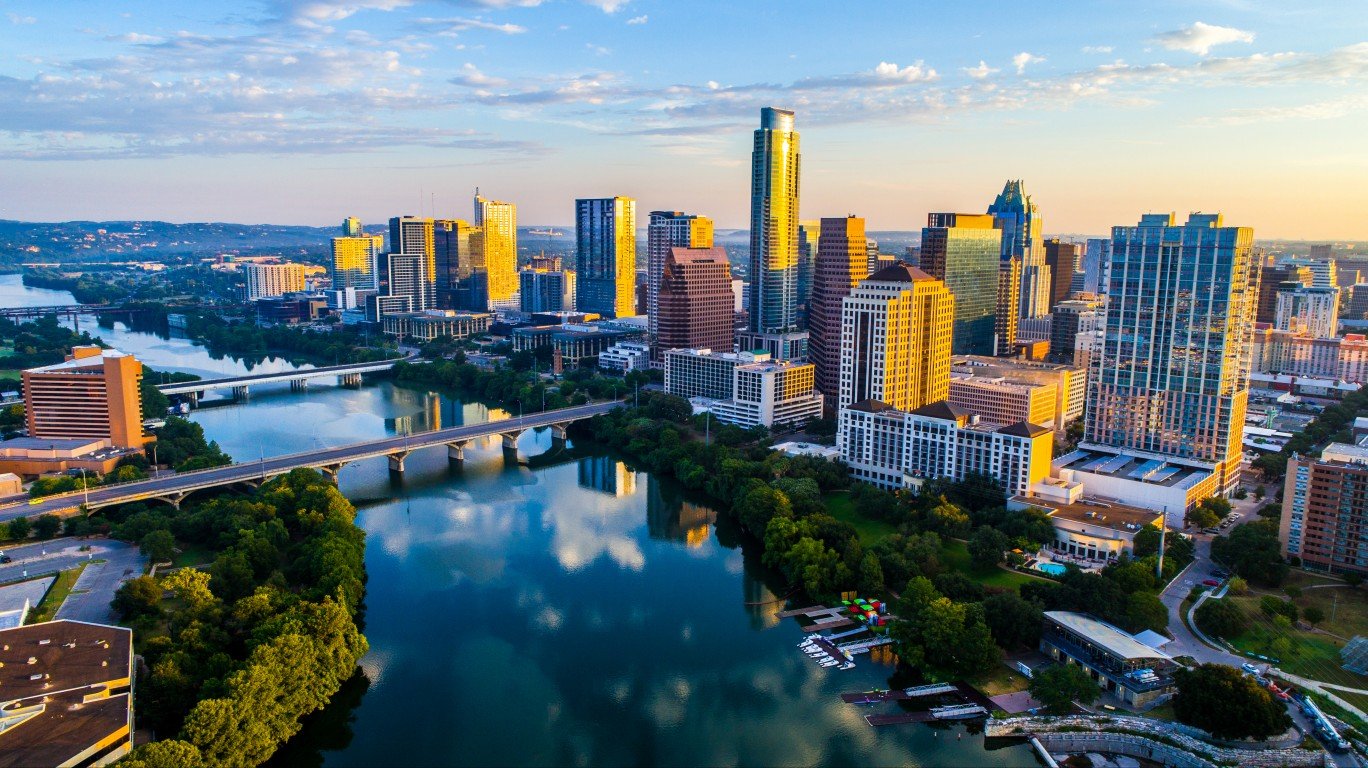
12. Austin-Round Rock-San Marcos, TX
> Patents granted in 2015 per 100,000 residents: 134.9
> Patents granted in 2015: 33,753
> Population: 2,000,860
> Adults with at least a bachelor’s degree: 44.8%
Austin, the capital of Texas, had the nation’s third fastest population growth from 2010 to 2017, climbing 22.5%, as people were likely attracted to the city by its reputation as a technology hub. The University of Texas, which is located in Austin, features the Innovation Center at the Cockrell School of Engineering that supports ideas, inventions and products created at the university. Like many cities on this list that have a prominent university, Austin’s percentage of adults with bachelor’s degrees or higher, at 44.8%, is well above the national percentage of 32.0%.
A report from real estate firm JLL’s Cities Research Centre earlier this year said Austin was one of the world’s most innovative cities. The report cited a combination of cost, culture, talent pipeline, and business-friendly environment that supports innovation in the city. Companies such as Dell, IBM, Amazon and Facebook have been drawn to the region, nicknamed “Silicon Hills” because of the number of technology companies there.
[in-text-ad-2]
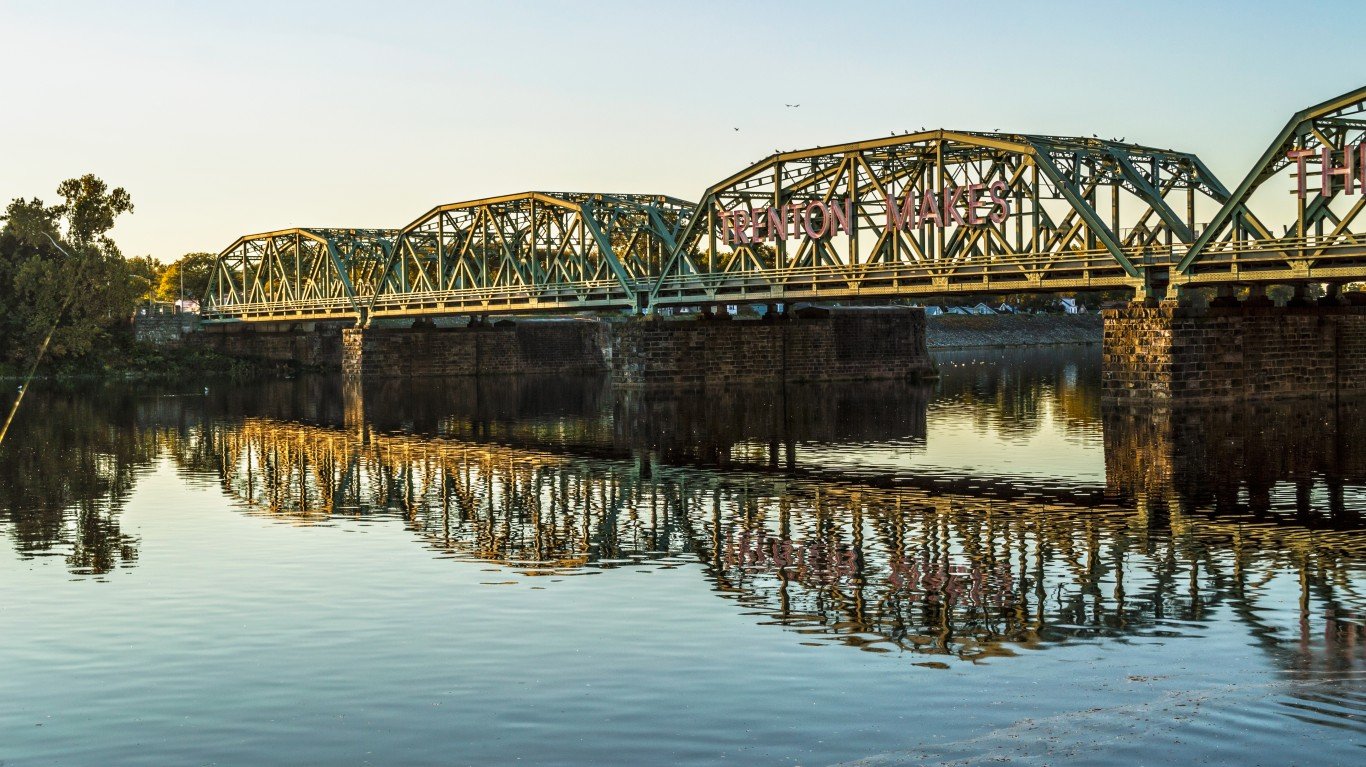
11. Trenton-Ewing, NJ
> Patents granted in 2015 per 100,000 residents: 145.9
> Patents granted in 2015: 5,810
> Population: 371,398
> Adults with at least a bachelor’s degree: 43.9%
The Trenton-Ewing region of central New Jersey owes its place on the list to its proximity to Princeton University — the school is 11 miles northeast of Trenton — as well as other institutions of higher learning such as the College of New Jersey in Ewing.
The state has been trying to boost the attractiveness of the biotechnology corridor around Route 1 in the central part of the state in recent years. Even though the pharmaceutical industry has reduced its presence in New Jersey over the last several decades, it remains a vital economic sector in the state. Johnson & Johnson is up the Turnpike in New Brunswick, and Bristol-Myers Squibb opened a 650,000-square-foot, four-building campus in Lawrenceville in 2016.
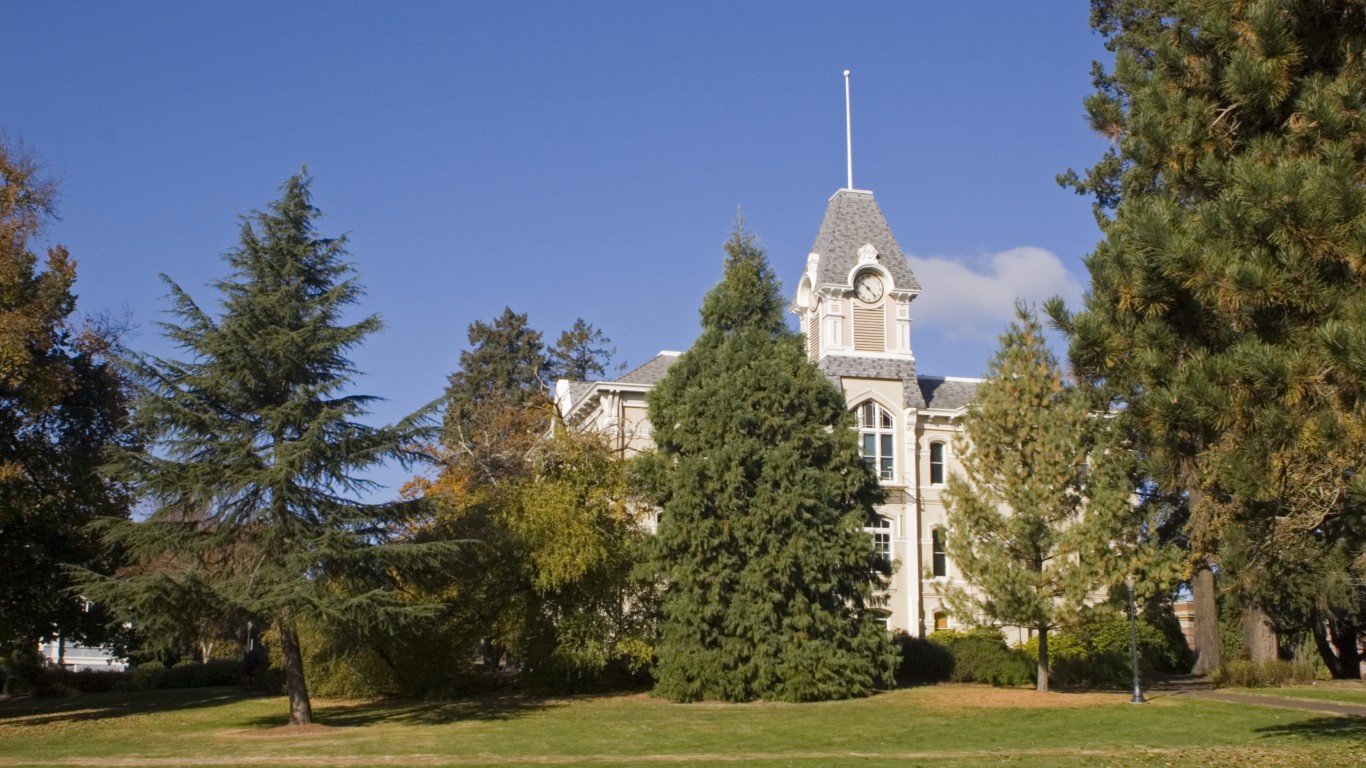
10. Corvallis, OR
> Patents granted in 2015 per 100,000 residents: 154.2
> Patents granted in 2015: 3,473
> Population: 87,572
> Adults with at least a bachelor’s degree: 53.8%
Corvallis, Oregon, has one of the most educated populations in the country, pointing to the presence of innovative companies. It has the third highest proportion of adults with a bachelor’s degree or higher, at 53.8%, compared with the U.S. proportion of 32.0%. In Corvallis, 97.3% of its adult population graduated from high school, the highest such share in the nation.
A major institution in Corvallis is Oregon State University, one of the city’s largest employers. OSU created the Oregon State University Advantage that forges connections between the business and academic communities to bring ideas to the marketplace. Among the companies with a presence in the city is computer maker Hewlett-Packard, which has a research campus in Corvallis. Hewlett-Packard employs about 1,700 people in Corvallis.
[in-text-ad]
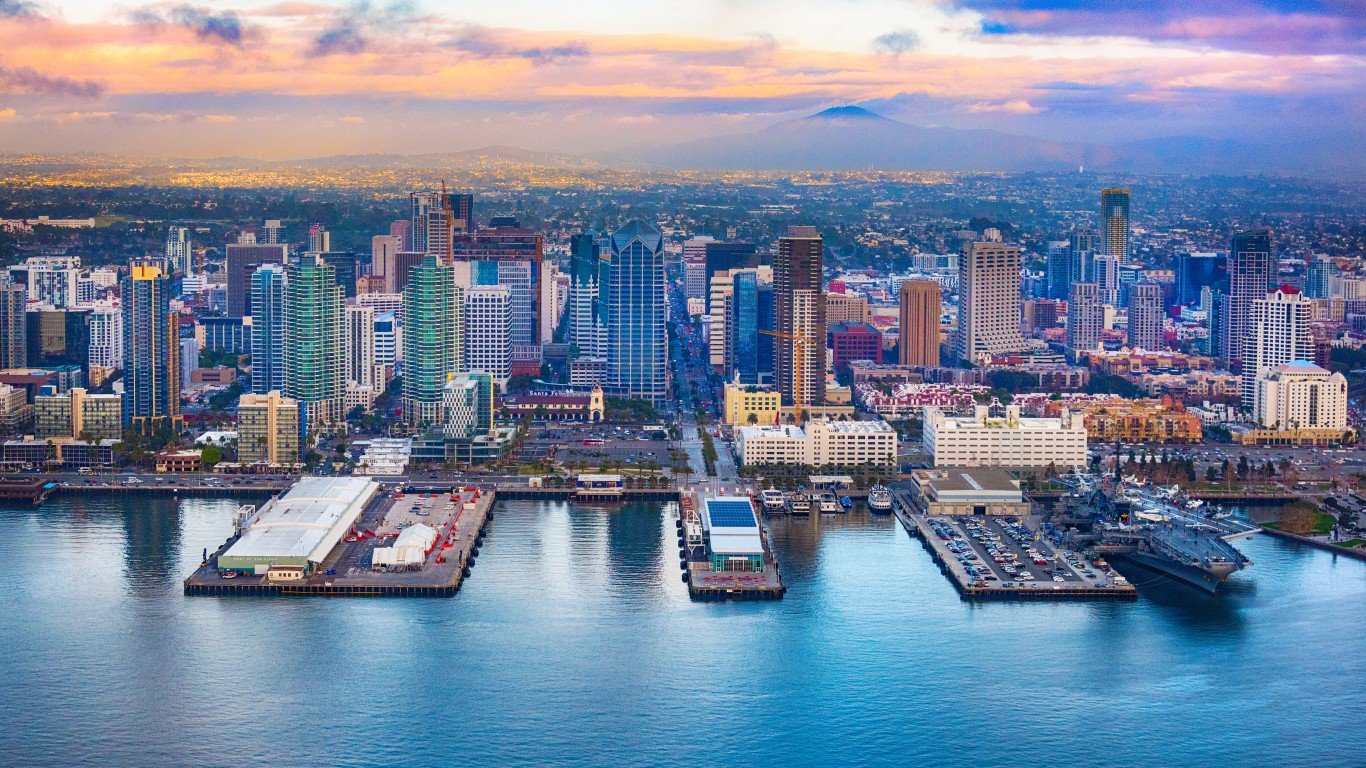
9. San Diego-Carlsbad-San Marcos, CA
> Patents granted in 2015 per 100,000 residents: 165.5
> Patents granted in 2015: 45,465
> Population: 3,299,521
> Adults with at least a bachelor’s degree: 38.8%
The famed beaches and weather of Southern California have helped attract entrepreneurs and innovators to the San Diego-Carlsbad-San Marcos area. The United States Chamber of Commerce has taken note of the area’s vitality and placed it fourth on its 2017 list of the nation’s most innovative cities.
A significant factor lifting San Diego’s reputation as a hub of innovation has been efforts of elected officials to engage the business community and grasp the needs of innovative startups. The chamber said wireless company Qualcomm has sponsored San Diego’s annual Seismic SD startup pitch event. San Diego State University has created an initiative called the Engineering and Interdisciplinary Sciences Complex designed to bring together engineers and scientists to collaborate on solutions for issues such as climate change.
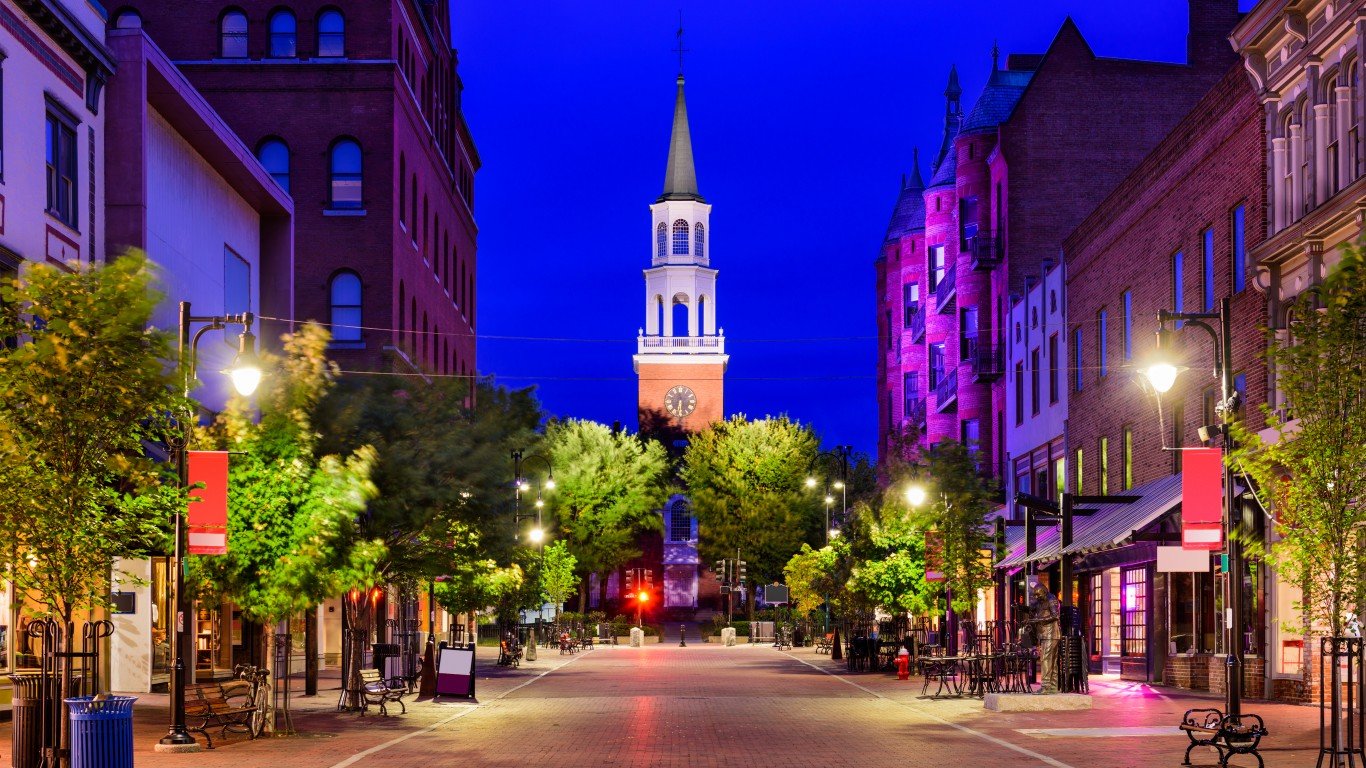
8. Burlington-South Burlington, VT
> Patents granted in 2015 per 100,000 residents: 169.4
> Patents granted in 2015: 6,263
> Population: 216,661
> Adults with at least a bachelor’s degree: 43.0%
With under 217,000 people, Burlington-South Burlington, Vermont is one of the smaller metro areas to have prolific patent output. The area had 367 patents granted in 2015, or more than 169 per 100,000 residents, eighth highest in the country. In 2013, Burlington became the smallest U.S. city to be designated as an IBM Smarter City. Burlington was chosen after it submitted an application proposing the city and IBM collaborate to work to reduce the city’s greenhouse gases. The IBM Smarter Cities Challenge was launched in 2010 and is an initiative involving IBM employees who work with city officials to address the technological challenges cities face..
The University of Vermont, the largest in the state, created the initiative UVM Innovations in 1999 to help companies commercialize new technologies that benefit society.
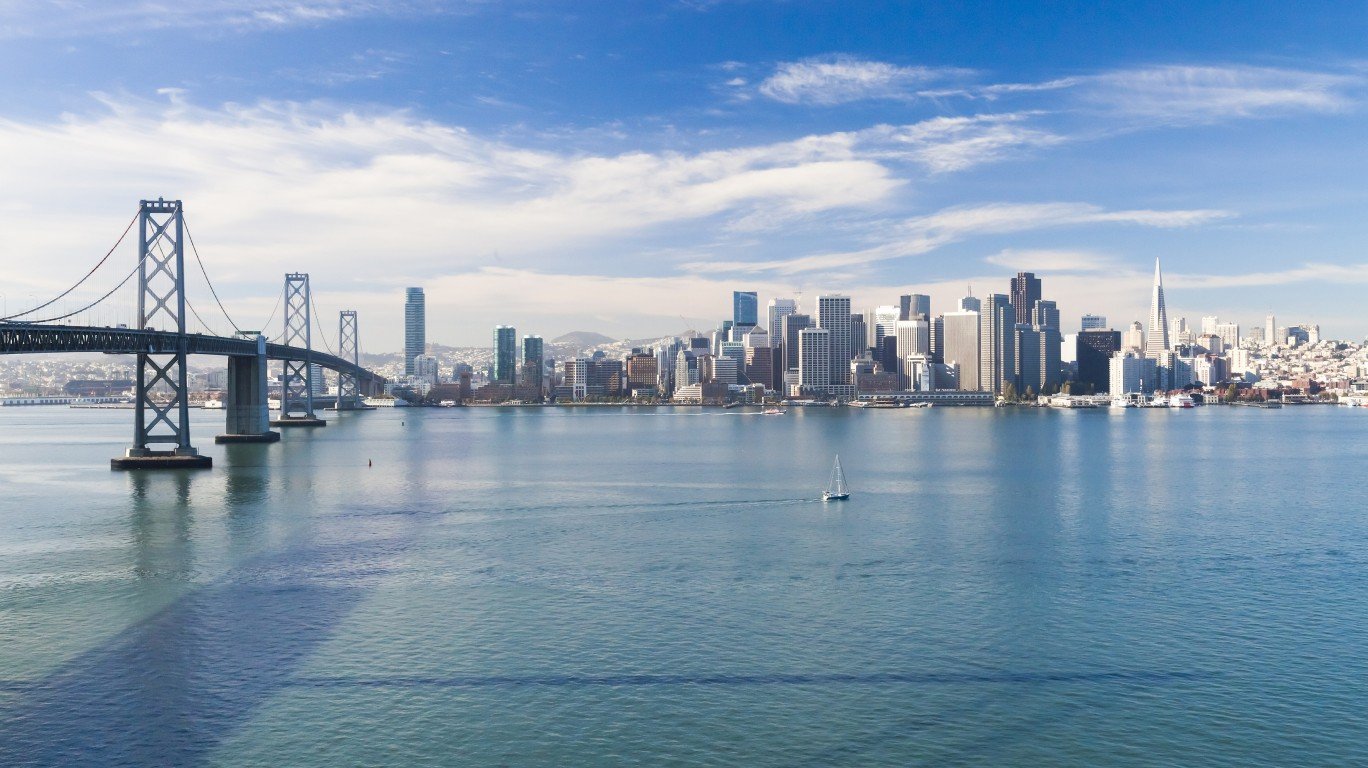
7. San Francisco-Oakland-Fremont, CA
> Patents granted in 2015 per 100,000 residents: 209.0
> Patents granted in 2015: 89,981
> Population: 4,656,132
> Adults with at least a bachelor’s degree: 49.3%
The San Francisco-Oakland-Fremont metro area is always on the short list of the most innovative cities. Earlier this year, business consulting firm AT Kearney released its list of the 135 top innovative cities in the world, and San Francisco led the rankings, getting high points for innovation and entrepreneurship. The Bay Area is home to tech giants like Facebook and Uber that churn out many patents annually. The report also said Google accounted for 6.5% of all international patent applications. Entrepreneurs enjoy the wealth of venture capital looking to bankroll the next big idea in the Bay Area.
The region is within 40 miles of two of the most prestigious universities in the country: Stanford and the University of California at Berkeley.
[in-text-ad-2]
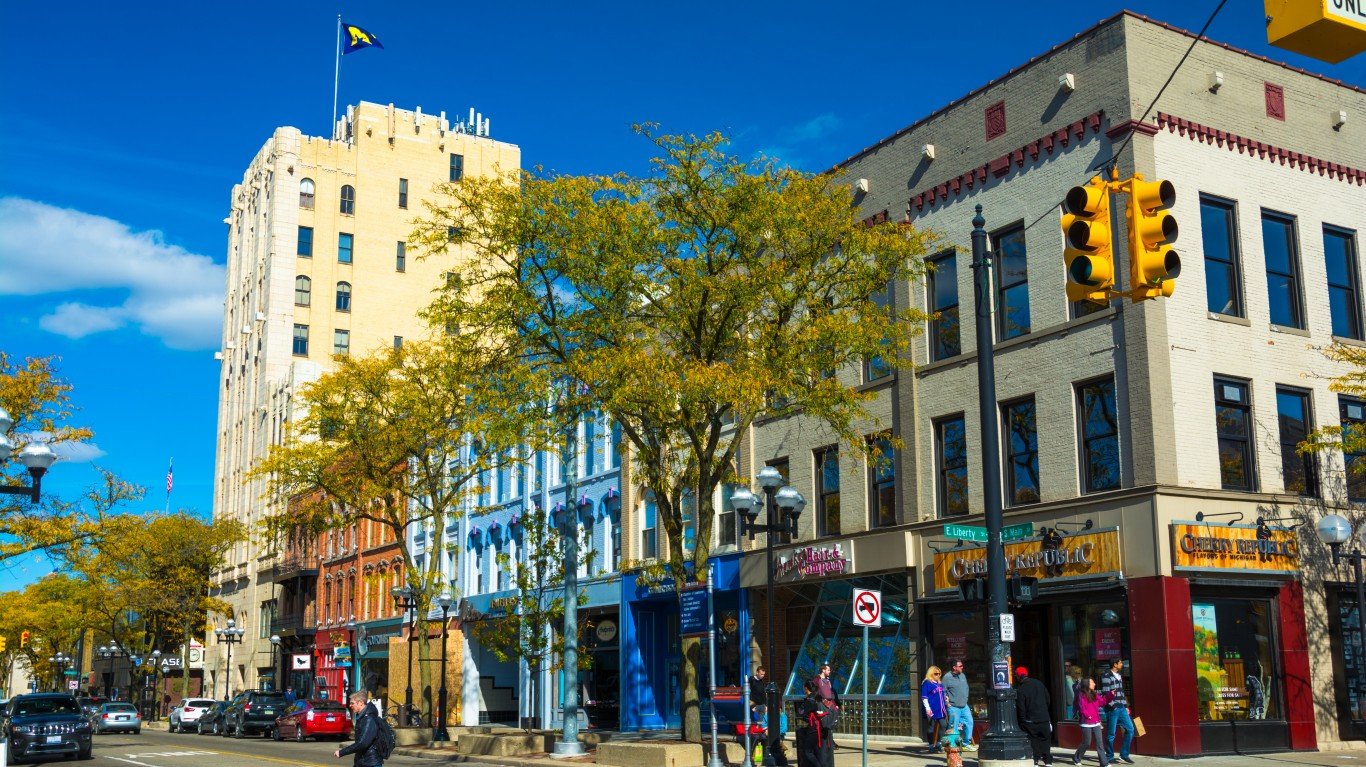
6. Ann Arbor, MI
> Patents granted in 2015 per 100,000 residents: 218.7
> Patents granted in 2015: 7,928
> Population: 358,880
> Adults with at least a bachelor’s degree: 54.5%
When you think of Ann Arbor, Michigan, you think of the University of Michigan. And Ann Arbor has a well-educated workforce. The percentage of adults in the city of about 359,000 with a bachelor’s degree or above is 54.5%, the second highest share on the list. Just over 95% of adult residents have a high school diploma, the 10th highest high school graduation rate of U.S. cities.
A consortium of banks, universities, tech companies and health care providers has invested in
Ann Arbor SPARK, an initiative intended to bring together a network of business and manufacturing companies and build awareness of the region and promote growth.
The University of Michigan has developed a destination for entrepreneurship and innovation called, Innovate Blue that supports and helps connect the university’s entrepreneurs. Innovate Blue claims to have more than 15 programs and centers in entrepreneurship. The university hopes to capitalize on the state’s legacy of innovation. It was over 100 years ago in Michigan that Henry Ford revolutionized the manufacturing business model by developing the assembly line that produced millions of Model T cars.
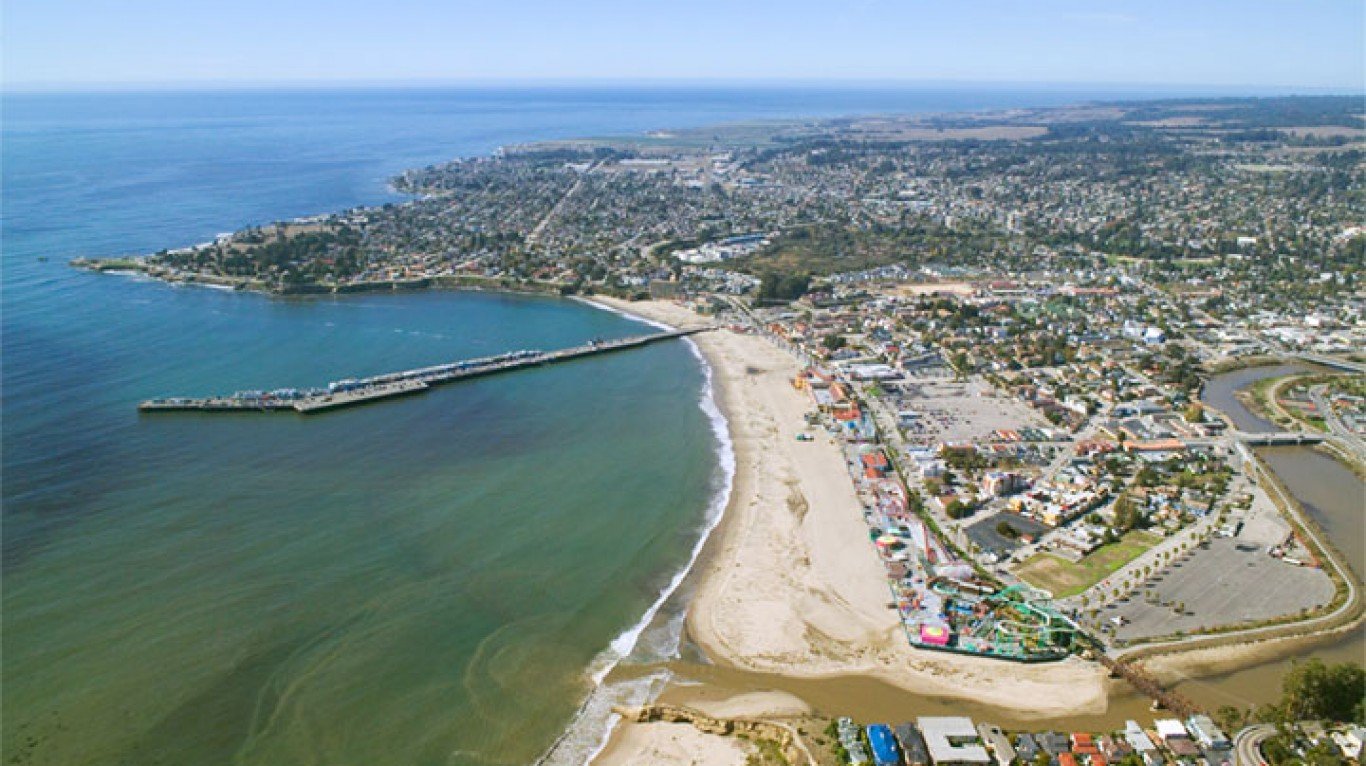
5. Santa Cruz-Watsonville, CA
> Patents granted in 2015 per 100,000 residents: 247.3
> Patents granted in 2015: 7,273
> Population: 274,146
> Adults with at least a bachelor’s degree: 40.2%
Santa Cruz, one of the smaller cities on our list with fewer than 300,000 residents. The city ranks among the most innovative in the country, with 247 patents per 100,000 people in 2015.
The metro area is home to the University of California at Santa Cruz, a research and educational hub, and one of the biggest employers in the city. UC Santa Cruz established the Startup Sandbox, an incubator created to provide help for startups to access affordable laboratory, office and shared space, as well as networking opportunities. The university also hosts Santa Cruz Works, a nonprofit corporation whose mission is to grow science and technology companies in Santa Cruz County.
[in-text-ad]

4. Boulder, CO
> Patents granted in 2015 per 100,000 residents: 260.2
> Patents granted in 2015: 9,137
> Population: 319,372
> Adults with at least a bachelor’s degree: 63.2%
The Boulder area has increasingly been home to technology companies. Stephan Weiler, professor of economics at Colorado State University in Fort Collins, told 24/7 Wall St. in an interview earlier this year that the region reminded him of the early days of Silicon Valley. Like many of the metro areas on this list, IBM has a large presence in the area, with several thousand employees working in Boulder. Other tech companies with operations in the region include Oracle and Seagate Technologies.
The main campus of the University of Colorado also is located in Boulder. The school is the largest in the state and a large employer in the metropolitan area. To get a better idea of how to measure innovation, earlier this year, Boulder Chamber of Commerce and the Boulder Economic Council created the Boulder Innovation Venture Report to compare the city with national innovation hubs such as Seattle and Silicon Valley on issues like investment capital, research and development, and quality of life.

3. Rochester, MN
> Patents granted in 2015 per 100,000 residents: 263.7
> Patents granted in 2015: 5,907
> Population: 213,873
> Adults with at least a bachelor’s degree: 39.2%
The Mayo Clinic is the biggest employer in the Rochester region, with almost 35,000 employees. Like so many metro areas on the list, IBM plays a significant economic role in the metro area and is a likely source of patent activity. Rochester accounted for about 264 patents per 100,000 people, the third highest on the list. In February, IBM sold its 492-acre campus in Rochester to a Los Angeles real estate group that plans to use the space to attract high-tech, medical, biomedical, and manufacturing businesses. IBM will be leasing eight of the 34 buildings on the campus.

2. Bremerton-Silverdale, WA
> Patents granted in 2015 per 100,000 residents: 348.7
> Patents granted in 2015: 7,278
> Population: 260,131
> Adults with at least a bachelor’s degree: 33.5%
Bremerton-Silverdale is one of two metro areas from Washington state on this list of the most innovative in the nation. Nearly 349 patents were granted in 2015 per 100,000 people in the region, the second highest patents per capita on the list.
Among the businesses on the cutting edge of innovation in Bremerton is SuperCritical Technologies. This company is working on processes to use carbon dioxide instead of steam to create electricity.
Applied Technical Systems and Gryphon Technologies are two technology companies with facilities in Silverdale that have received federal and defense contracts, including agreements to develop a floating radar system.
[in-text-ad-2]
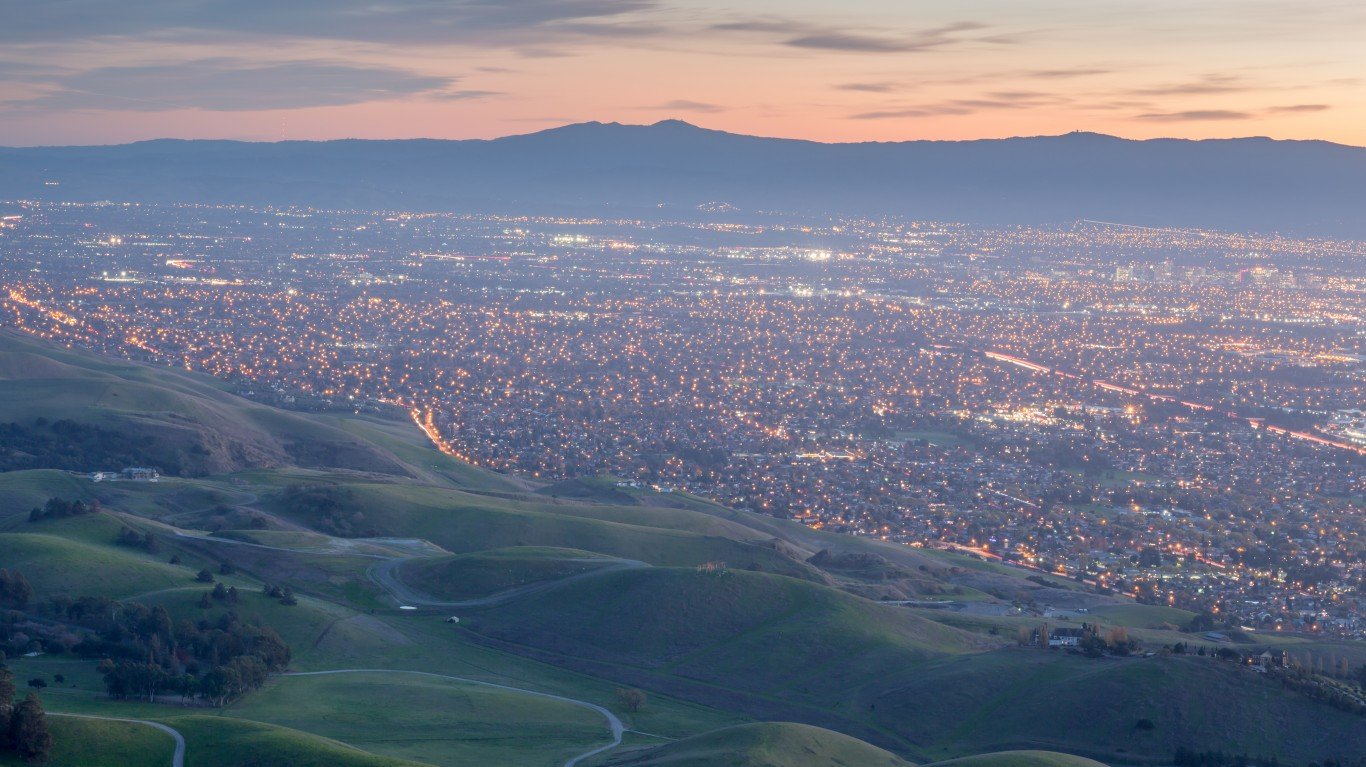
1. San Jose-Sunnyvale-Santa Clara, CA
> Patents granted in 2015 per 100,000 residents: 739.5
> Patents granted in 2015: 143,473
> Population: 1,976,836
> Adults with at least a bachelor’s degree: 50.8%
The San Jose-Sunnyvale-Santa Clara, California metro area tops the list of most innovative cities. The region generated 14,618 patents in 2015, or a whopping 739 per 100,000 people, more than double the per-capita output of second place Bremerton-Silverdale, Washington.
The metro area is home to Silicon Valley, the nation’s most well-known home to major tech companies and incubator for tech startups. Stanford University is located in the San Jose region and has some of the most renowned science and technology programs in the world. Other noteworthy institutions in the area include the University of California-Davis and Santa Clara University. Students graduating with tech degrees do not have to look far to start their careers, with companies such as Google and Facebook offering lucrative jobs.
San Jose is also the location of The Tech: Museum of Innovation, which was founded in 1978. Its mission is to “celebrate the present and encourage the development of innovative technology.”
Detailed Findings
Patent activity has become more closely watched in recent years. The stakes could not be higher for the United States, whose future as an economic powerhouse depends on the growth and vitality of the technology sector.
Earlier this year, the Trump administration lodged a complaint with the World Trade Organization claiming China was violating patent and copyright laws, then the administration slapped tariffs on China.
A study by the Brookings Institution detailed how patenting in a variety of scientific fields has been increasing in the United States over the last several decades. The study said high patent production in some metro areas can be largely explained by the presence of major research institutions, especially those with well-regarded programs in science, technology, engineering and mathematics (STEM).
Many metro areas on this list are home to offices, headquarters, or plants of large companies. This is the case with Google and Hewlett-Packard in California. Both of these companies work closely with universities’ STEM programs to nurture tech talent and develop patents. In Boston, startups in the biotech and software fields work in concert with the area’s renowned research universities such as Harvard and Massachusetts Institute of Technology.
Venture capital funding also is a strong factor in helping stoke innovation. According to a TechCrunch story earlier this year, Boston was poised to regain its-second place ranking in venture investment behind Silicon Valley. TechCrunch reported the metro area had attracted $5.2 billion in investment funding as of July. Boston is an incubator of startups in biotech, enterprise software, artificial intelligence, and consumer apps.
In addition to education and venture capital, city and business leadership have become advocates for innovation. Cary, North Carolina, has embraced smart technology and is using a challenge grant awarded to it by the Smart Cities Council — an organization focused on sustainable solutions — to open data platforms, public wi-fi, as well as other initiatives.
The cities on the 24/7 list typically have higher educational attainment, pointing to the presence of innovation-heavy companies and workers capable of engaging in this type of research and production. In 22 of the 25 cities on the list, the bachelor’s degree attainment rate exceeds the national rate of 32%.
The 25 most innovative cities in the United States are not limited to one region.
Of the 25 cities on the list, five are in California, powered by Silicon Valley and the presence of companies such as Apple, Facebook, and Google. The San Jose-Sunnyvale-Santa Clara, California, region tops the list with 739.46 patents per 100,000 residents. The U.S. average is 42.06 per 100,000. The region was granted 14,618 patents in 2015, close to 5,000 more than the metro area receiving the second-most patents — San Francisco.
New York and Colorado are represented by three cities each. Areas in upstate New York such as Ithaca tap the research clout of Cornell University, while legacy companies like specialty glass maker Corning Inc. are trying to develop technology to adapt to the 21st century. Areas like Greeley and Fort Collins in Colorado have been incubators of tech startups, reflecting the entrepreneurial spirit of the region. Those cities are also among the fastest growing in terms of population in the United States.
North Carolina and Washington have two cities on the list. The Research Triangle has been a driving force for innovation and patent generation in the region of North Carolina that includes universities such as Duke, North Carolina, and North Carolina State. In Washington state, online e-commerce giant Amazon and technology powerhouse Microsoft have propelled innovation.
Methodology
24/7 Wall St. compiled the list of most innovative U.S. cities by using data from the U.S. Patent and Trademark Office. The 25 most innovative cities in the United States were those with the highest number of patents issued per 100,000 city residents. Population data is for 2015 and is from the U.S. Census Bureau’s American Community Survey. Content material was derived from technology-focused periodicals such as TechCrunch, company and university websites, wire services, and other media sources.
Sponsored: Find a Qualified Financial Advisor
Finding a qualified financial advisor doesn’t have to be hard. SmartAsset’s free tool matches you with up to 3 fiduciary financial advisors in your area in 5 minutes. Each advisor has been vetted by SmartAsset and is held to a fiduciary standard to act in your best interests. If you’re ready to be matched with local advisors that can help you achieve your financial goals, get started now.
Thank you for reading! Have some feedback for us?
Contact the 24/7 Wall St. editorial team.
 24/7 Wall St.
24/7 Wall St. 24/7 Wall St.
24/7 Wall St. 24/7 Wall St.
24/7 Wall St. 24/7 Wall St.
24/7 Wall St.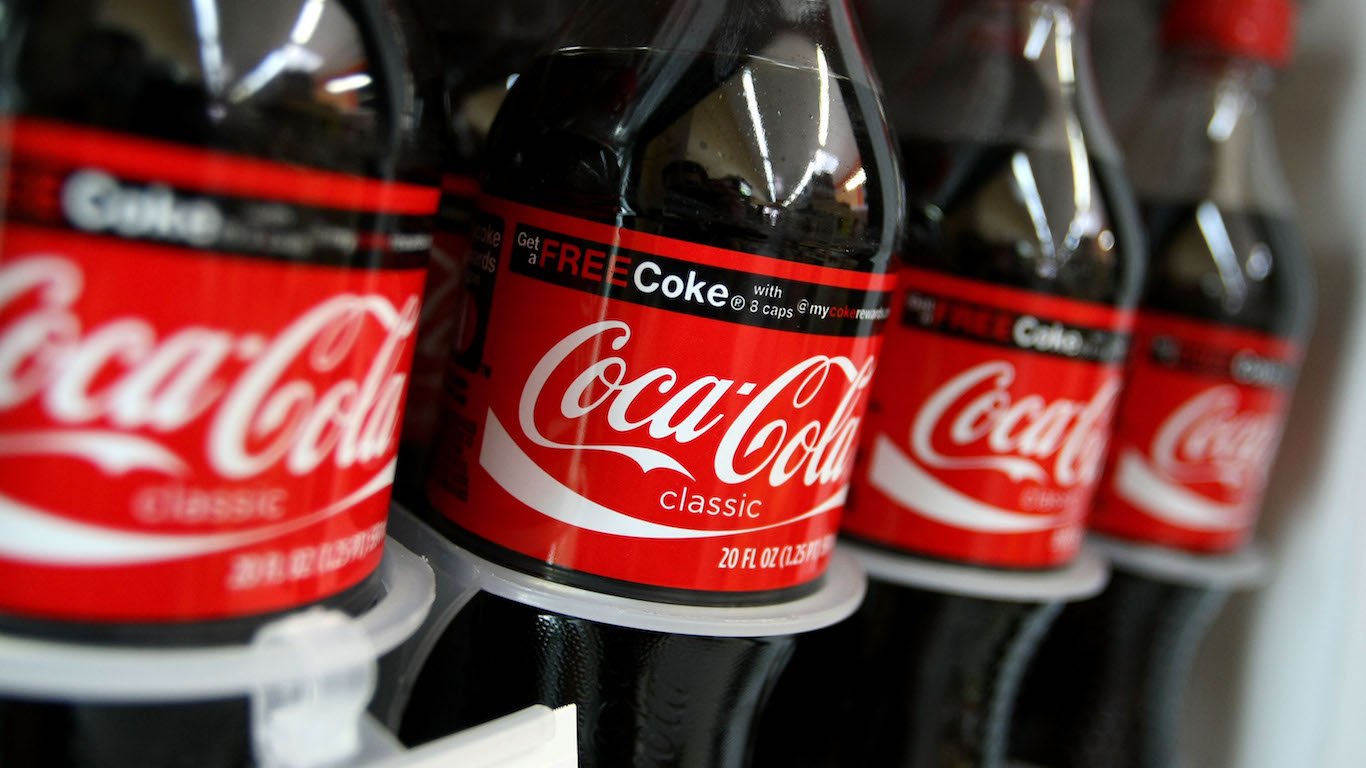 24/7 Wall St.
24/7 Wall St.
